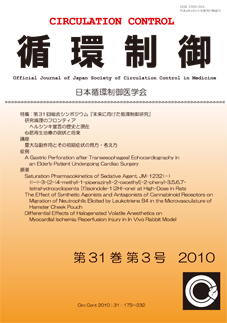31 巻, 3 号
選択された号の論文の4件中1~4を表示しています
- |<
- <
- 1
- >
- >|
症例
-
原稿種別: case reports
2010 年 31 巻 3 号 p. 193-195
発行日: 2010年
公開日: 2013/05/31
PDF形式でダウンロード (131K)
原著
-
原稿種別: original articles
2010 年 31 巻 3 号 p. 196-201
発行日: 2010年
公開日: 2013/05/31
PDF形式でダウンロード (234K) -
原稿種別: original articles
2010 年 31 巻 3 号 p. 202-207
発行日: 2010年
公開日: 2013/05/31
PDF形式でダウンロード (249K) -
原稿種別: original articles
2010 年 31 巻 3 号 p. 208-213
発行日: 2010年
公開日: 2013/05/31
PDF形式でダウンロード (213K)
- |<
- <
- 1
- >
- >|
